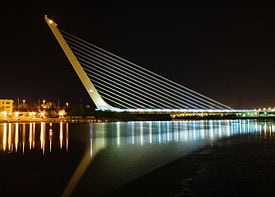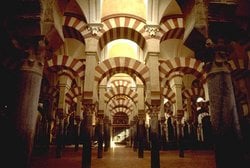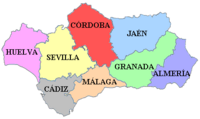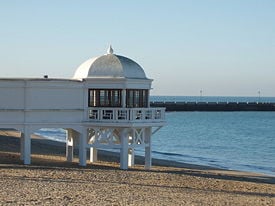Difference between revisions of "Andalusia" - New World Encyclopedia
Mary Anglin (talk | contribs) |
Mary Anglin (talk | contribs) (images okay) |
||
| Line 1: | Line 1: | ||
| − | {{claimed}}{{Contracted}} | + | {{Images OK}}{{claimed}}{{Contracted}} |
{{Autonomous community | {{Autonomous community | ||
| Line 21: | Line 21: | ||
|english-name = Andalusian | |english-name = Andalusian | ||
|spanish-name = Andaluz, andaluza | |spanish-name = Andaluz, andaluza | ||
| − | |autonomy = December 30 1981 | + | |autonomy = December 30, 1981 |
|congress = 62 | |congress = 62 | ||
|senate = 40 | |senate = 40 | ||
| Line 108: | Line 108: | ||
While the agricultural portions of the economy continue to struggle, the service sector is becoming a significant part of the national product of Andalusia. Manufacturing and service sectors are growing exponentially, with the growth rates in Andalusia exceeding those found elsewhere in Spain. High growth rates in the service sector are expected to continue, especially as tourism becomes more prominent in the area. | While the agricultural portions of the economy continue to struggle, the service sector is becoming a significant part of the national product of Andalusia. Manufacturing and service sectors are growing exponentially, with the growth rates in Andalusia exceeding those found elsewhere in Spain. High growth rates in the service sector are expected to continue, especially as tourism becomes more prominent in the area. | ||
| − | + | [[Image:Malecón de La Caleta, Cádiz.JPG|thumb|275px|[[Malecón]] of La Caleta, Cádiz.]] | |
== Culture == | == Culture == | ||
| Line 114: | Line 114: | ||
The modern day [[culture]] of Andalusia draws heavily on its Moorish history. It is considered to be one of the most colorful regions of Spain, with ornamentation playing a large role in clothing. [[Dance]] and [[music]] are also vital to the culture of Andalusia, with the most popular performance dance being the [[flamenco]]. Flamenco, while most often performed by [[Roma]] gypsies has gained popularity around the globe. Two distinct types of flamenco exist in Andalusia, those which are choreographed, and those which are not. Unchoreographed flamenco dance is referred to as cante jondo, and has a less structured musical rhythm than choreographed flamenco. | The modern day [[culture]] of Andalusia draws heavily on its Moorish history. It is considered to be one of the most colorful regions of Spain, with ornamentation playing a large role in clothing. [[Dance]] and [[music]] are also vital to the culture of Andalusia, with the most popular performance dance being the [[flamenco]]. Flamenco, while most often performed by [[Roma]] gypsies has gained popularity around the globe. Two distinct types of flamenco exist in Andalusia, those which are choreographed, and those which are not. Unchoreographed flamenco dance is referred to as cante jondo, and has a less structured musical rhythm than choreographed flamenco. | ||
| − | + | ||
| − | |||
== References == | == References == | ||
| Line 123: | Line 122: | ||
==External links== | ==External links== | ||
| − | *[http://www.andalucia.org/modulos.php?modulo=Index&nuevoidioma=eng Official Tourism Website of Andalusia]Retrieved November 18, 2007. | + | *[http://www.andalucia.org/modulos.php?modulo=Index&nuevoidioma=eng Official Tourism Website of Andalusia] Retrieved November 18, 2007. |
| − | *[http://www.crwflags.com/fotw/flags/es-an_hi.html History of the Andalusian Flag]Retrieved November 18, 2007. | + | *[http://www.crwflags.com/fotw/flags/es-an_hi.html History of the Andalusian Flag] Retrieved November 18, 2007. |
| − | *[http://www.paradoxplace.com/Photo%20Pages/Spain/Andalucia/Andalucia.htm Andalucia Photo and History Pages]Retrieved November 18, 2007. | + | *[http://www.paradoxplace.com/Photo%20Pages/Spain/Andalucia/Andalucia.htm Andalucia Photo and History Pages] Retrieved November 18, 2007. |
*[http://www.fiestasdeandalucia.com/FiestasdeAndalucia.com, Fairs and Festivals in Andalusia] Retrieved November 18, 2007. | *[http://www.fiestasdeandalucia.com/FiestasdeAndalucia.com, Fairs and Festivals in Andalusia] Retrieved November 18, 2007. | ||
| − | *[http://www.infoplease.com/ce6/world/A0803911.html, Andalusia]Retrieved November 18, 2007. | + | *[http://www.infoplease.com/ce6/world/A0803911.html, Andalusia] Retrieved November 18, 2007. |
{{Provinces of Andalusia}} | {{Provinces of Andalusia}} | ||
Revision as of 03:03, 22 November 2007
| |||||
| Motto: Andalucía por sí, para España y la humanidad (Andalusia by herself, for Spain, and for humankind) | |||||
| Anthem: La bandera blanca y verde | |||||
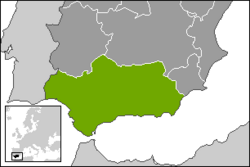
| |||||
| Capital | |||||
| Official language(s) | Spanish | ||||
| Area – Total – % of Spain |
Ranked 2nd 87,268 km² 17.2% | ||||
| Population – Total (2006) – % of Spain – Density |
Ranked 1st 7,975,672 17.84 91.39/km² | ||||
| Demonym – English – Spanish |
Andalusian Andaluz, andaluza | ||||
| Statute of Autonomy | December 30, 1981 | ||||
| Parliamentary representation – Congress seats – Senate seats |
62 40 | ||||
| President | Manuel Chaves González (PSOE) | ||||
| ISO 3166-2 | AN | ||||
| Junta de Andalucía | |||||
Andalusia, located in the southern portion of Spain, is one of the seventeen autonomous regions of the country. It contains eight distinct provinces, all with individual cultural traditions and identity. With eight provinces ( Almeria, Cadiz, Cordoba, Granada, Huelva, Jaen, Malaga,and Seville ) , Andalusia boasts the largest population of any of the autonomous Spanish states. In terms of land mass, Andalusia is the second largest of the autonomous regions of Spain, second only to the region of Castilla y Leon.
Andalusia lies to the south of Extremadura and Castilla-La Mancha, meeting the Mediterranean Sea on its southern border. Its eastern neighbor is the autonomous community of Murcia, while the country of Portugal lies along its western border. Past Portugal to the west lies the Atlantic Ocean. Andalusia also conveniently located along the strait of Gibraltar, the passage between the Atlantic Ocean and the Mediterranean Sea. The prime position along the strait was also recognized by Great Britain, who controls a small area of land bordering Andalusia.
Geography
The terrain of Andalusia varies greatly depending on the area of the region. Towards the coast the terrain descends into the famous beaches of Spain, notable for their fine sands and constant sunshine. The weather along the coast is also far more temperate than the interior of the region, another reason that attracts the tourists. The beach, however, is not the only the only reason tourists flock to Andalusia. The mountains are also spectacular, and they host a unique combination of plant and animal life.
The main geographic feature of the region is the Andalusian Plain, which runs from the Sierra Morena in the north to the Sistema Penibetico in the south. The plain is fundamentally a large river valley that surrounds the Rio Guadlquivir, and it broadens wherever possible. The valley reaches its narrowest point where the Sierra Morena and the Sistema Penibetico meet in the eastern portion of the region. Minor valleys are also common in Andalusia, although none rival the breath and size of the Andalusian Plain.
History
The earliest records of settled civilization in Andalusia describe colonial occupation in Pre-Roman times. In the early 12th century B.C.E. the Phoenician empire formed colonies along the coast to help with trade. The settlement founded by the Phoenicians was called Tartessos, which later rose to become a major political force in the region.
The colonies of the Phoenicians eventually declined in power following the dissolution of the Phoenician empire. The next major political force to emerge in the region was the city of Carthage, whose emphasis on trade gave the straits of Gibraltar and the Andalusia region economic importance. As a trading center, Carthage saw the economic value of controlling the strait, and began a campaign to gain control of the region. Between the first and second Carthaginian wars, Carthage extended its power over Andalusia, using the coast to launch many of its invasions into Roman territory. Carthage, however, was unsuccessful in its campaign against Rome. With the decline of Carthage, Andalusia remained, for a brief period, without a strong political identity. Rome stepped in to fill the power vacuum, renaming the area Betica.
Roman control over the area did not last long, with the area briefly falling under the control of the Vandals. As the Vandals passed through the region on their way to North Africa, they took control of Andalusia. Following their brief occupation, the Visigoths took control, only to be replaced by Muslim rule in the early 8th century C.E. The Muslim invasion proved to be an extremely influential action in the formation of a distinct Andalusian identity.
During the half millennium of Muslim rule during the Middle Ages, Andalusia became an extremely wealthy and influential political force that actively cultivated scholarship and advances in many areas. Córdoba became the largest and richest city in Western Europe and one of the largest in the world. The Moors established universities in Andalucia, and cultivated scholarship, bringing together the greatest achievements of all of the civilizations they had encountered. During that period Moorish and Jewish scholars played a major part in reviving and contributing to Western astronomy, medicine, philosophy and mathematics.
In 1248 Seville fell to Castilian rule. After the fall of Seville, the Andalusia region began to experience a large influx of Moors who were fleeing the Reconquista. The Moorish influx contributed significantly to the distinctive Andalusian culture that is apparent today. Moorish influences were particularly strong in architecture, with prominent examples found at the Alhambra and the Giralda towers.
Archaeological ruins include Medina Azahara, near Córdoba, and the Roman city of Itálica, near Seville, and at Palos, in the province of Huelva, the Andalusian port from which Columbus's expedition of discovery was launched.
The Spanish language spoken in the Americas today is largely descended from the Andalusian dialect of Spanish. Although the Spanish spoken at the Canary Islands resembles more the Spanish spoken in the Caribbean. This is due to the role played by Seville as the gateway to Spain's American territories during the sixteenth and seventeenth centuries.
Government
Andalusia began its own distinct political force in 1978, when the Spanish constitution established historical nationalities. Historical nationalities in Spain, like Andalusia, were granted a special, autonomous status that was based on the idea that the area contained a specific nationality. Another major idea behind historical nationalities was their supposed independence from Spain as a whole. Under this idea Historical Nationalities were areas that were considered culturally independent prior to the second Spanish War. Andalusia is one of only four such regions in Spain, with the other historical nationalities found in Catalonia, Basque, and Galicia. Many other communities in Spain were recognized as a result of the constitution, but other communities were not granted the political and cultural independence of historical nationalities.
Administrative divisions
| Province | Capital | Population | Density | Municipalities |
|---|---|---|---|---|
| Almería | Almería | 635.850 | 72,47 hab./km² | Municipalities |
| Cádiz | Cádiz | 1.180.817 | 158,80 hab./km² | Municipalities |
| Córdoba | Córdoba | 788.287 | 72,47 hab./km² | Municipalities |
| Granada | Granada | 882.184 | 68,70 hab./km² | Municipalities |
| Huelva | Huelva | 483.792 | 47,67 hab./km² | Municipalities |
| Jaén | Jaén | 662.751 | 49,09 hab./km² | Municipalities |
| Málaga | Málaga | 1.491.287 | 204,06 hab./km² | Municipalities |
| Seville | Seville | 1.813.908 | 129,23 hab./km² | Municipalities |
Other important Andalusian cities are:
- El Ejido, and Roquetas de Mar, Almería
- La Línea de la Concepción, Algeciras, Sanlúcar de Barrameda, Rota, San Fernando, Jerez, and El Puerto, Cádiz
- Almuñécar, Guadix, Loja and Motril, Granada
- Linares, Úbeda and Baeza, Jaén
- Antequera, Ronda and Marbella, Málaga
- Dos Hermanas, Lebrija, Osuna and Utrera, Sevilla
Economy
Andalusia is particularly rich in natural resources, but despite this fact, Andalusia continues to have one of the lowest GDP per capita in Spain. The economic difficulties of the region are commonly attributed to poor soil conditions. With rocky soil throughout the state and a subtropical climate, Andalusia is agriculturally comparable to North Africa. Major agricultural products of the region include olive oil and wine, whose production levels are gradually increasing with increased mechanization. The natural wealth of the region is found in its mineral deposits, particularly copper, iron, zinc, and lead. These minerals have been drawn from the region since Phoenician and Roman times.
While the agricultural portions of the economy continue to struggle, the service sector is becoming a significant part of the national product of Andalusia. Manufacturing and service sectors are growing exponentially, with the growth rates in Andalusia exceeding those found elsewhere in Spain. High growth rates in the service sector are expected to continue, especially as tourism becomes more prominent in the area.
Culture
The modern day culture of Andalusia draws heavily on its Moorish history. It is considered to be one of the most colorful regions of Spain, with ornamentation playing a large role in clothing. Dance and music are also vital to the culture of Andalusia, with the most popular performance dance being the flamenco. Flamenco, while most often performed by Roma gypsies has gained popularity around the globe. Two distinct types of flamenco exist in Andalusia, those which are choreographed, and those which are not. Unchoreographed flamenco dance is referred to as cante jondo, and has a less structured musical rhythm than choreographed flamenco.
ReferencesISBN links support NWE through referral fees
- Lewis, Brenda Ralph. 2002. Great Civilizations. Parragon Publishing, Bath. ISBN 0-75256-141-3
- Costantino, Maria. 2001. The Illustrated Flag Handbook. Gramercy Books, New York. ISBN 0-517-21810-0
- Noble, John. 2007. Lonely Planet Andalucia. Lonely Planet Publications. ISBN 174059973X
External links
- Official Tourism Website of Andalusia Retrieved November 18, 2007.
- History of the Andalusian Flag Retrieved November 18, 2007.
- Andalucia Photo and History Pages Retrieved November 18, 2007.
- Fairs and Festivals in Andalusia Retrieved November 18, 2007.
- Andalusia Retrieved November 18, 2007.
| |||||||||
| |||||||
Credits
New World Encyclopedia writers and editors rewrote and completed the Wikipedia article in accordance with New World Encyclopedia standards. This article abides by terms of the Creative Commons CC-by-sa 3.0 License (CC-by-sa), which may be used and disseminated with proper attribution. Credit is due under the terms of this license that can reference both the New World Encyclopedia contributors and the selfless volunteer contributors of the Wikimedia Foundation. To cite this article click here for a list of acceptable citing formats.The history of earlier contributions by wikipedians is accessible to researchers here:
- Andalusia history
- Historical_regions_in_Spain history
- Geography_of_Spain history
- Music_of_Andalusia history
- Andalusian_people history
The history of this article since it was imported to New World Encyclopedia:
Note: Some restrictions may apply to use of individual images which are separately licensed.

